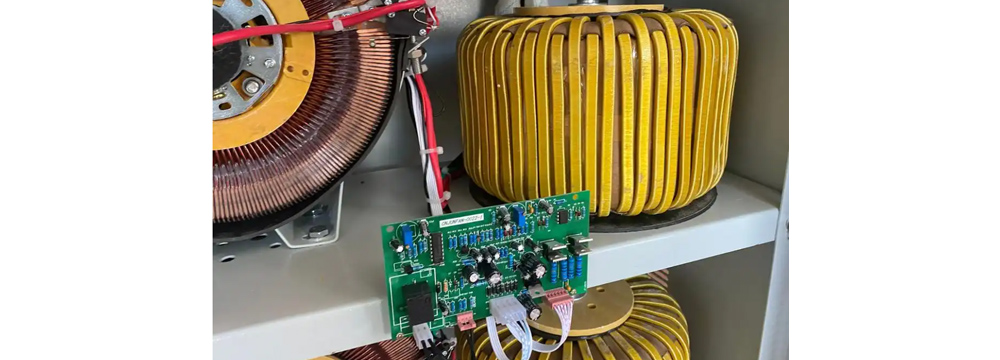A regulated power supply is a power supply that converts an unstable voltage into a stable voltage. It is divided into two types: AC regulated power supply and DC regulated power supply. Their main differences are the output voltage type and working principle. This article will popularize the difference between AC regulated power supply and DC regulated power supply to help you better choose such components. First, let's take a look at the basic concepts of AC regulated power supply and DC regulated power supply:
1. AC regulated power supply
1.1 What is an AC regulated power supply?
AC regulated power supply is a power supply that converts the input AC signal into a fixed output voltage with stability. It can meet the requirements of various electronic devices for voltage stability while providing a safer and more stable power supply. AC regulated power supply is widely used in electronics, communications, military industry and other fields, and is an indispensable and important tool in modern industrial production.
The basic principle of AC regulated power supply is to convert the input AC signal into DC through a rectifier and filter circuit, and then adjust the voltage through a voltage stabilization circuit, and finally maintain a fixed voltage and current at the output end. The three-terminal voltage regulator chip is usually used in the voltage stabilization circuit, which can maintain the stability of the output voltage under the condition of load current changes and input voltage changes.
AC regulated power supplies have high output current and voltage stability, so they are used in various electronic devices, instruments and laboratories that require precision and reliability. For example, communication equipment and systems require stable and reliable power to ensure that there are no changes or interference during signal transmission. Laboratories and test equipment require precise voltage and current for accurate measurements and experiments.
The types and specifications of AC regulated power supplies are also very diverse. The output current and voltage can range from a few milliamperes to several thousand amperes, and the output voltage can range from a few volts to hundreds of volts. In addition, AC regulated power supplies also have a variety of protection features such as overheating protection, short circuit protection and overload protection, which can ensure safety and reliability during its operation.
1.2. The advantages of AC regulated power supplies include:
Voltage stability: The AC regulated power supply can monitor the changes in input voltage in real time through the internal automatic adjustment mechanism, and adjust the output voltage to keep it within the set stability range, thereby ensuring the normal operation of the equipment. .Protect equipment safety: When the grid voltage is too high or too low, the AC voltage stabilizer can sense and adjust the output voltage in time to prevent the equipment from being damaged by overvoltage or undervoltage, and protect electronic components from damage.
Adapt to different grid environments: In areas with large voltage fluctuations or weak power infrastructure, the AC voltage stabilizer can automatically adapt to the complex grid environment to ensure the normal use of electrical equipment.
Reduce harmonic interference: Some advanced models of AC voltage stabilizers also have filtering functions, which can reduce harmonic interference in the grid and improve power quality.
Optimize power factor: By adjusting the power factor of the load, optimize power utilization, reduce reactive power loss, and reduce electricity costs.
1.3.Application scenarios of AC voltage stabilizers include:
Industrial production lines: Ensure the stable operation of production equipment and improve production efficiency.
Medical equipment: Protect medical equipment from voltage fluctuations and ensure the accuracy of diagnostic and treatment equipment.
Computer system: Prevent data loss or system crash caused by voltage fluctuations and ensure stable operation of computer systems.
Household appliances: Protect household appliances from voltage fluctuations and extend the service life of appliances.
Communication equipment: Ensure the stable operation of communication equipment and ensure the stability and reliability of signal transmission.

2. DC regulated power supply
2.1 What is a DC regulated power supply?
DC regulated power supply refers to a power supply composed of a transformer, rectifier, filter and regulator that changes the output voltage of the DC regulated power supply according to factors such as ambient temperature, load size, and input voltage. The input voltage level is reduced to a suitable level through a transformer, and then the AC is converted to DC through a rectifier, and the sine wave of the output voltage is converted into a smooth DC signal through a filter, and finally the output voltage is maintained stable by a regulator.
DC regulated power supply is widely used in industry, communications, medical care, military and other fields. It can provide reliable, stable, low ripple and high-precision output voltage, enabling various electronic devices to work normally. In industrial production, it can help equipment achieve precision control and improve production quality and efficiency. In the field of communications, it can ensure the stable operation of communication equipment and improve the quality and reliability of communication. In the medical and military fields, power supply stability is crucial to the safe operation of equipment.
In the design of DC regulated power supply, key parameters include output voltage, output current, ripple and stability. In order to meet the needs of different applications, different parameters such as power supply capacity, stability, output voltage and current can be selected, and attention should be paid to the efficiency, reliability and safety of the power supply.
2.2. The advantages of DC regulated power supply include:
High stability: DC regulated power supply can provide continuous and stable DC power to meet the requirements of electronic equipment for power supply circuits.
Small ripple: The ripple of its output voltage is small, and it can provide high-quality DC power.
High reliability: If the design is reasonable, the reliability of DC regulated power supply is high, which is suitable for occasions requiring stable power supply.
Multiple output: It is easy to achieve multiple outputs, which is suitable for occasions requiring multiple independent power supplies.
2.3 Application fields of DC regulated power supply include:
Industrial production: In industrial production, DC regulated power supply can help equipment achieve precise control and improve production quality and efficiency.
Communication field: Ensure the stable operation of communication equipment and improve communication quality and reliability.
Medical field: The stability of power supply is crucial to the safe operation of medical equipment.
Military field: DC regulated power supply is also widely used in the military field to ensure the stable operation of equipment.

3. The difference between AC regulated power supply and DC regulated power supply
AC regulated power supply is a power supply that converts AC power into a stable and adjustable AC power supply. Its working principle is to use a transformer to convert the input AC power into AC power of intermediate frequency, and then through rectification, smoothing, filtering, and regulating the voltage stabilization circuit, finally output stable AC power. AC regulated power supply is widely used in laboratories, factories, hospitals and other fields for power supply, electrochemical analysis, optoelectronic devices, communication and testing.
DC regulated power supply is a power supply that converts AC power or unstable DC power supply into a stable and adjustable DC power supply. Its working principle is to use a transformer to convert the input AC power into AC power of intermediate frequency, and then stabilize the output voltage at the set value through rectification, smoothing and adjusting the voltage stabilization circuit. DC regulated power supplies are widely used in electronic instruments, communications, factory equipment, automotive electronics, lighting, medical and other fields.
The difference between AC regulated power supply and DC regulated power supply is that DC power supply will not change, while AC power has a change cycle. AC power E=Emsinwt, Em is the peak value of AC voltage, that is, the maximum value, while DC voltage remains unchanged, and AC power also has an effective value. According to the thermal effect of current, the general nameplate or voltmeter is marked or measured with effective value. It is precisely because AC power changes periodically that capacitors can charge and discharge in a short time, so AC power can pass through capacitors, while DC power cannot pass through current.
Share our interesting knowledge and stories on social media













